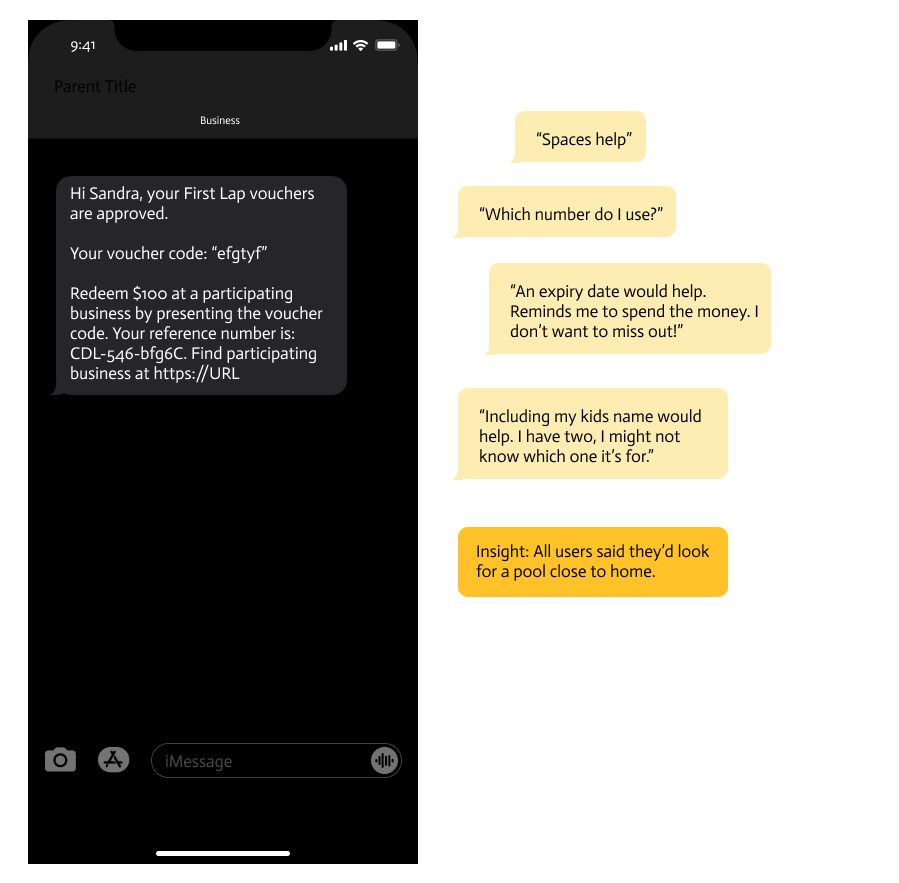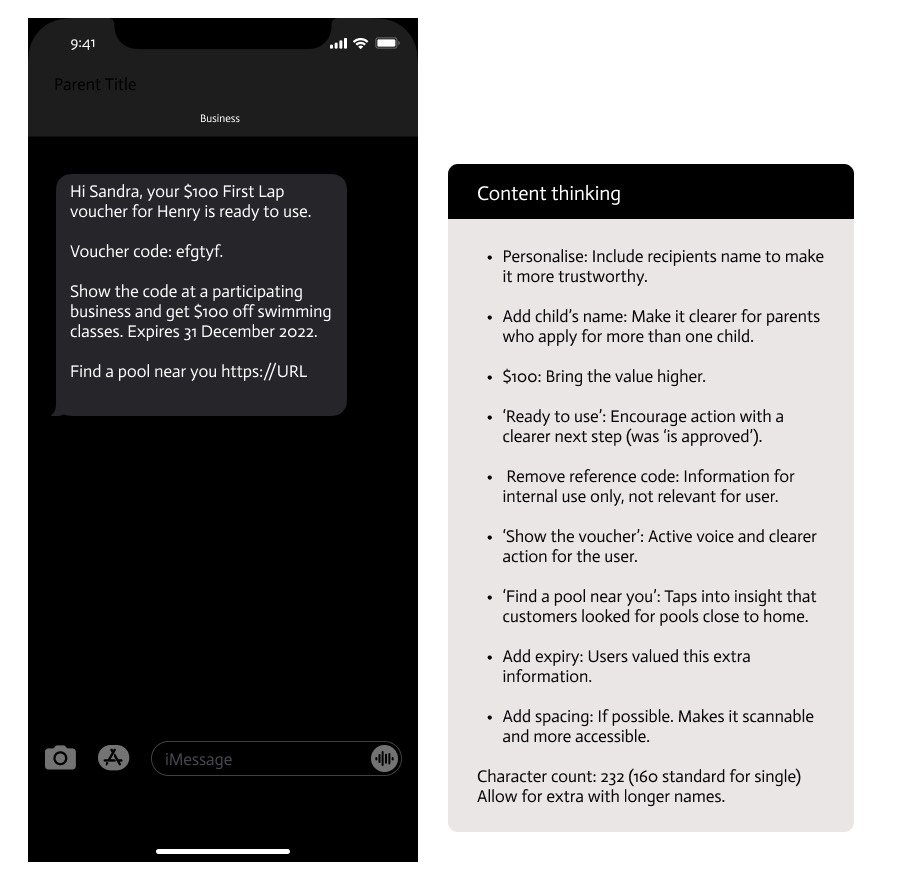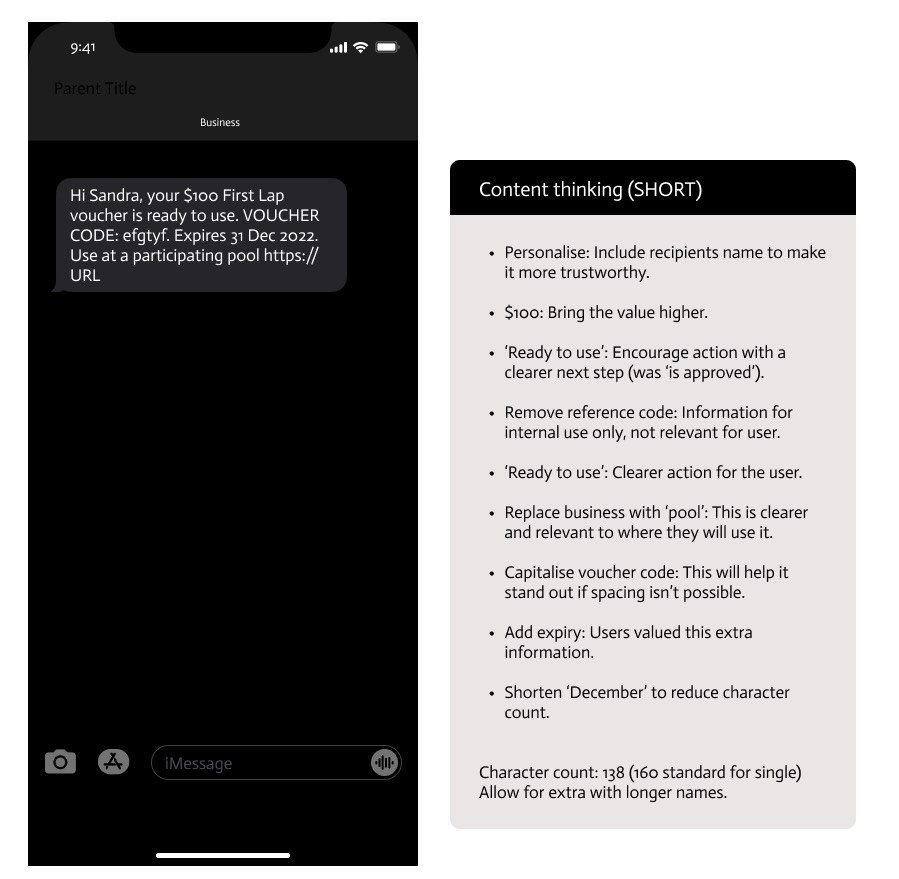Spammy SMS
Our brief
Working with three other UX designers, we were tasked with a multi-channel UX review of our company’s existing voucher schemes. (A government agency).
We needed to find user problems we could solve for. Then ideate, test and deliver a series of low-fi solutions to inform an upcoming voucher scheme.
Ten user problems brought to the ideation phase.
We interviewed frontline staff (service and call centres) and mined support ticket data and social forums to identify and prioritise ten user problems to tackle.
For this case study, we’ll look at a more content-y one. Problem #5.
10 problems. Here’s #5
Problem #5
Users feel the SMS is unclear and doesn’t look ‘official’
Call centre and service centre staff were receiving calls from customers confused by the SMS voucher they’d received. They didn’t understand what information to use and many thought it was spam. Frontline was also getting calls from businesses (accepting the vouchers) confused about what information they could input to redeem the SMS.
Dig deeper
Original SMS brought to guerilla testing.
Because our discovery was limited to secondary feedback, I tested the original SMS with five eligible users in guerilla tests.
I wanted to better understand:
How might a user interact with the content?
What might be confusing, unclear and untrustworthy about the SMS?
Iterate and retest
I spoke to a program SME to understand what information was essential to redeem the voucher (and importantly, what we could scrap). As well as available fields.
Using what we learned, and some content suggestions of my own, I mocked up a revised SMS prototype.
I partnered with a product designer to add some questions to our discussion guide for upcoming moderated user testing. We had a few solutions to test, so added this in.
We wanted to learn:
How might a user redeem this voucher?
What information would a user be on the lookout for?
Is there anything they don’t understand about this SMS?
Revised SMS for user testing.
And what users had to say.
Deliver
I took the user feedback to revise and deliver a proposed SMS to the team, alongside a suite of other low-fi solutions.
The final SMS.
Content thinking
Personalise: Up trust and make it targeted.
Let the $ shine: Bring the dollar value into the lead.
Encourage action: ‘Ready to use’ is clearer than ‘is approved’.
Remove excess: Internal codes are for internal use, don’t confuse users with them.
Tap into behaviours: Users tend to visit local pools. Encourage action with ‘Find a pool near you’ (not ‘for participating businesses visit…’).
Add spacing (if possible): This makes it more accessible.
Add expiry: Help the user know when they need to use it.
Sender ID: Up trust. Where you can’t include the business name look to add the business name at the end. Though not the preference.
Hindsight: Although desirable for customers, I learned a child's name in the SMS breached privacy standards. I would build privacy checks into my content process moving forward.
Want it shorter?
I also provided a shorter version, without spaces. Though not ideal, it’s an alternative if the platform didn’t allow for spacing and the team really wanted to get it under the 160 character limit.
The shorter extra variation SMS.
Results
I don’t have impact data for this work. But I’d measure impact with:
📈 Reduction in bounces to the webpage from the SMS referral link.
📈 Reduction in support calls about the SMS.
Thinking back…
I was new to the organisation. And our brief was to inform a single voucher. If I did it again I’d see if the feedback could help us build out an SMS template. To test, document, and share for use in other voucher schemes (rather than as a one-off solution).
Why an SMS though?
The voucher scheme wanted to incentivise parents and carers to enrol young children into swimming lessons. While most customers access vouchers in the Service NSW app, not all users want (or could) use the app. With accessibility a priority for the government, SMS vouchers were available as a supplementary channel for all vouchers at the time. In our user research, we learned that SMS was a preferred method for ‘non-traditional’ families, think families with shared parenting responsibilities. This is because it didn’t bind redemption to a single user’s login account.




